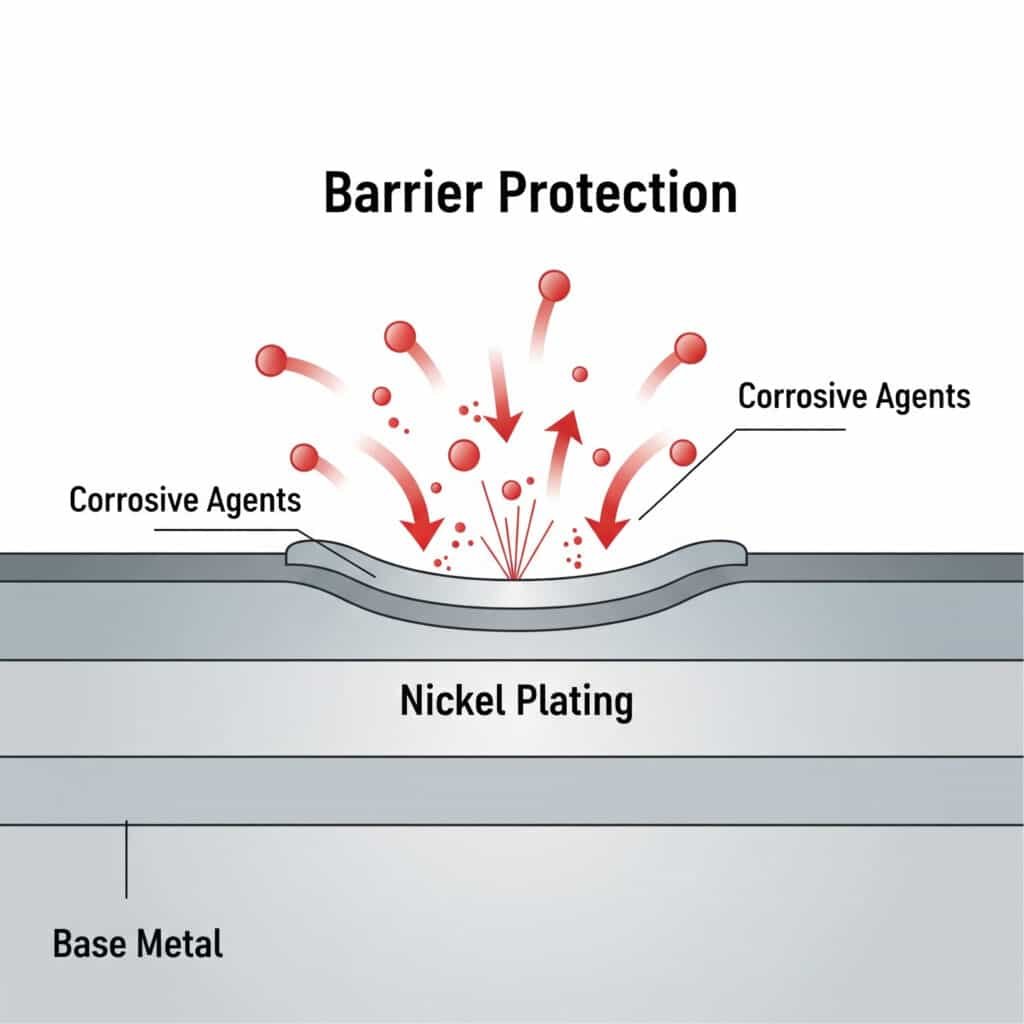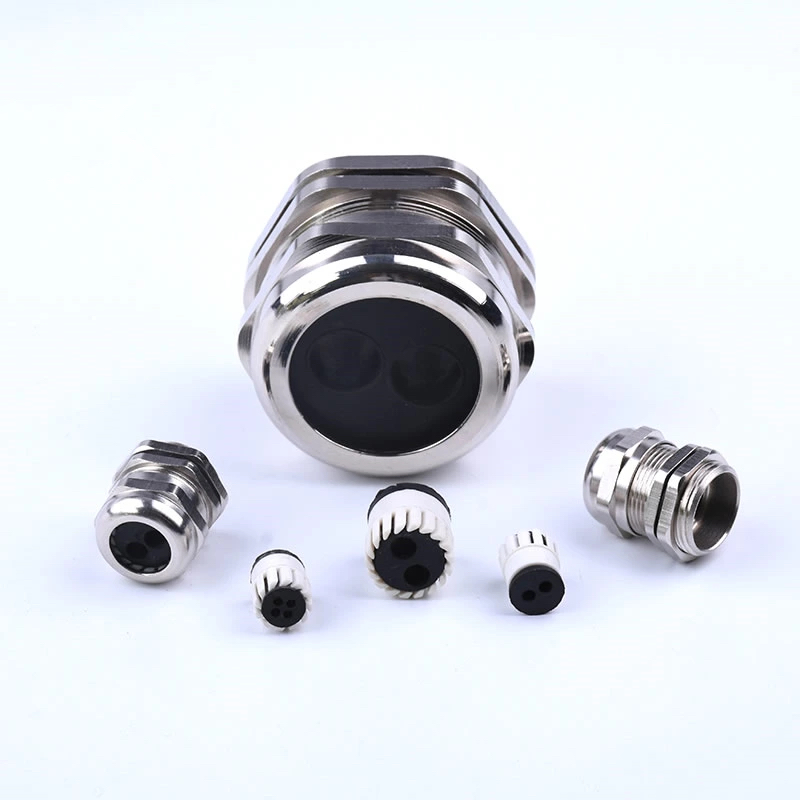Introduction
“Chuck, our marine cable glands are corroding within 6 months instead of lasting the expected 5 years!” This urgent call from Captain Lars, managing offshore wind installations in the North Sea, highlighted a critical oversight many engineers make. His team had specified unplated brass cable glands for cost savings, not realizing that proper plating could have prevented 90% of their corrosion failures.
Nickel and zinc plating enhance cable gland performance by providing corrosion resistance (extending lifespan by 300-500%), improving electrical conductivity (reducing contact resistance by 40-60%), and offering superior surface hardness (increasing wear resistance by 200-400%) compared to unplated metals. These protective coatings transform ordinary metal cable glands into high-performance components capable of withstanding harsh industrial environments for decades.
After analyzing plating performance across 25,000+ cable glands in extreme environments—from chemical plants to marine installations—I’ve learned that the right plating choice isn’t just about corrosion protection. It’s about optimizing every aspect of performance while managing total cost of ownership1. Let me share the insights that have helped our clients achieve 99.2% field reliability through strategic plating selection.
Table of Contents
- What Are the Key Differences Between Nickel and Zinc Plating?
- How Does Plating Improve Corrosion Resistance in Cable Glands?
- Which Plating Type Offers Better Performance for Specific Applications?
- What Are the Cost-Benefit Considerations for Different Plating Options?
- FAQs About Cable Gland Plating and Coatings
What Are the Key Differences Between Nickel and Zinc Plating?
Understanding the fundamental differences between nickel and zinc plating is crucial for selecting the optimal coating for your cable gland applications.
Nickel plating provides superior corrosion resistance (500+ hours salt spray vs. 96 hours for zinc), better wear resistance (450 HV hardness vs. 70 HV for zinc), and excellent electrical conductivity, while zinc plating offers sacrificial protection, lower cost (60% less than nickel), and easier application processes. Each plating type serves different performance priorities and application requirements.
Nickel Plating Characteristics
Physical Properties:
- Hardness: 450-600 HV (Vickers Hardness2)
- Thickness: Typically 5-25 micrometers
- Appearance: Bright, mirror-like finish
- Melting Point: 1,455°C
- Electrical Resistivity: 6.84 × 10⁻⁸ Ω·m
Performance Advantages:
- Corrosion Resistance: Excellent barrier protection against moisture, chemicals, and salt spray
- Wear Resistance: Hard surface resists mechanical damage during installation and operation
- Temperature Stability: Maintains properties from -40°C to +150°C
- Chemical Compatibility: Inert to most industrial chemicals and solvents
Zinc Plating Characteristics
Physical Properties:
- Hardness: 70-120 HV (Vickers Hardness)
- Thickness: Typically 8-25 micrometers
- Appearance: Bright silver to dull gray finish
- Melting Point: 419°C
- Electrical Resistivity: 5.96 × 10⁻⁸ Ω·m
Performance Advantages:
- Sacrificial Protection3: Zinc corrodes preferentially, protecting the base metal
- Self-Healing: Minor scratches don’t compromise protection due to galvanic action
- Cost Effectiveness: Lower material and processing costs
- Easy Processing: Simple electroplating with good coverage uniformity
Comparative Performance Analysis
| Property | Nickel Plating | Zinc Plating | Advantage |
|---|---|---|---|
| Corrosion Resistance | 500+ hours ASTM B1174 | 96-200 hours ASTM B117 | Nickel |
| Hardness | 450-600 HV | 70-120 HV | Nickel |
| Wear Resistance | Excellent | Moderate | Nickel |
| Cost | High | Low | Zinc |
| Temperature Range | -40°C to +150°C | -40°C to +100°C | Nickel |
| Electrical Conductivity | Excellent | Good | Nickel |
Hassan, who manages several petrochemical facilities in Kuwait, learned these differences through expensive experience. His initial zinc-plated cable glands failed within 18 months due to the aggressive chemical environment. After switching to our nickel-plated designs, he achieved 7+ years reliable service. “The upfront cost was double, but the total cost of ownership dropped by 65%,” he reported during our last facility audit.
How Does Plating Improve Corrosion Resistance in Cable Glands?
Plating provides multiple layers of protection that dramatically extend cable gland lifespan in corrosive environments through both barrier and sacrificial protection mechanisms.
Plating improves corrosion resistance by creating impermeable barriers (nickel) that block corrosive agents from reaching base metals, or through sacrificial protection (zinc) where the coating corrodes preferentially, extending base metal life by 300-800% depending on environmental severity. This protection is essential for maintaining IP ratings and structural integrity over decades of service.

Barrier Protection Mechanism (Nickel)
How Nickel Protects:
Nickel plating creates a dense, non-porous barrier that prevents corrosive agents from reaching the base metal:
- Molecular Density: Nickel’s crystalline structure blocks moisture and chemical penetration
- Chemical Inertness: Resists reaction with acids, bases, and salt solutions
- Adhesion Strength: Strong metallurgical bond prevents coating delamination
- Uniform Coverage: Electroplating ensures complete surface protection
Performance in Different Environments:
- Marine Environments: 500+ hours salt spray resistance vs. 24 hours for unplated brass
- Chemical Plants: Resistant to most industrial chemicals and solvents
- High Humidity: Maintains protection at 95%+ relative humidity
- Temperature Cycling: Stable protection through thermal expansion cycles
Sacrificial Protection Mechanism (Zinc)
How Zinc Protects:
Zinc plating provides galvanic protection by corroding preferentially to the base metal:
- Electrochemical Series5: Zinc is more anodic than steel, brass, or aluminum
- Galvanic Action: Creates protective current flow that inhibits base metal corrosion
- Self-Healing: Zinc ions migrate to protect small scratches and defects
- Controlled Corrosion: Zinc corrodes slowly and predictably
Protection Duration:
- Thickness Dependency: Each 10 micrometers provides approximately 2-3 years protection
- Environment Impact: Salt spray reduces protection life by 50-70%
- Chromate Treatment: Adds additional 100-200% protection life
- Maintenance Coating: Can be renewed without component replacement
Real-World Corrosion Performance Data
Marine Environment Testing (ASTM B117 Salt Spray):
- Unplated Brass: First corrosion at 24 hours, significant damage at 96 hours
- Zinc Plated (12μm): First corrosion at 96 hours, breakthrough at 200 hours
- Nickel Plated (15μm): First corrosion at 500+ hours, minimal damage at 1000 hours
Industrial Chemical Environment:
David, managing a chlorine production facility in Germany, provided valuable field data. His zinc-plated cable glands lasted 2.5 years in moderate chemical exposure, while nickel-plated units in the same environment showed minimal corrosion after 6 years. “The nickel plating paid for itself within 3 years through reduced maintenance and replacement costs,” he confirmed.
Plating Quality Factors
Critical Quality Parameters:
- Thickness Uniformity: ±20% variation maximum for consistent protection
- Adhesion Strength: >30 MPa bond strength to prevent delamination
- Porosity Control: <5 pores/cm² for effective barrier protection
- Surface Preparation: Proper cleaning and activation for optimal adhesion
Which Plating Type Offers Better Performance for Specific Applications?
Application-specific requirements determine the optimal plating choice, with each type excelling in different operational environments and performance priorities.
Nickel plating excels in high-temperature applications (+100°C to +150°C), chemical processing environments, and precision electronics requiring superior conductivity, while zinc plating performs optimally in moderate outdoor environments, cost-sensitive applications, and installations requiring sacrificial protection for steel components. Proper application matching ensures maximum performance and cost-effectiveness.

Nickel Plating Applications
Optimal Use Cases:
- Chemical Processing: Refineries, pharmaceutical plants, chemical manufacturing
- High-Temperature Environments: Power generation, industrial furnaces, automotive
- Marine/Offshore: Subsea installations, ship systems, offshore platforms
- Electronics/Telecommunications: Data centers, control panels, sensitive equipment
- Food Processing: Sanitary applications requiring easy cleaning and corrosion resistance
Performance Advantages in These Applications:
- Chemical Resistance: Withstands acids, bases, and organic solvents
- Temperature Stability: Maintains properties at elevated temperatures
- Electrical Performance: Low contact resistance for reliable connections
- Hygiene Compliance: Non-porous surface prevents bacterial growth
- Longevity: 10-20 year service life in demanding environments
Zinc Plating Applications
Optimal Use Cases:
- General Industrial: Manufacturing facilities, warehouses, standard installations
- Outdoor/Weather Exposure: Utility installations, telecommunications towers, infrastructure
- Cost-Sensitive Projects: Large-scale installations where economics drive decisions
- Steel Protection: Applications where galvanic compatibility with steel is beneficial
- Moderate Environments: Indoor installations with occasional moisture exposure
Performance Advantages in These Applications:
- Cost Effectiveness: 40-60% lower initial cost than nickel plating
- Self-Healing Protection: Minor damage doesn’t compromise overall protection
- Easy Maintenance: Can be renewed through zinc-rich paint application
- Galvanic Compatibility: Works well with galvanized steel systems
- Adequate Performance: Meets requirements for moderate environmental exposure
Application-Specific Selection Matrix
| Application Type | Environment Severity | Recommended Plating | Expected Lifespan | Cost Factor |
|---|---|---|---|---|
| Chemical Plant | High | Nickel | 10-15 years | 2.0x |
| Marine/Offshore | Very High | Nickel | 15-20 years | 2.0x |
| General Industrial | Medium | Zinc | 5-8 years | 1.0x |
| Outdoor Telecom | Medium-High | Zinc + Chromate | 6-10 years | 1.2x |
| Food Processing | High | Nickel | 12-18 years | 2.0x |
| Electronics | Medium | Nickel | 15+ years | 2.0x |
Hybrid Approaches
Multi-Layer Systems:
For extreme applications, we sometimes recommend layered plating systems:
- Zinc Base + Nickel Top: Combines sacrificial protection with barrier protection
- Copper Strike + Nickel: Improves adhesion and electrical performance
- Chromate Post-Treatment: Adds additional corrosion resistance to zinc plating
Hassan’s petrochemical facility uses our hybrid zinc-nickel system for critical applications. The zinc provides sacrificial protection while the nickel top layer offers chemical resistance. “It’s 30% more expensive than single-layer plating but gives us the best of both worlds,” he explained during our last technical review.
What Are the Cost-Benefit Considerations for Different Plating Options?
Understanding the total cost of ownership, including initial investment, maintenance requirements, and replacement cycles, is essential for making economically sound plating decisions.
Nickel plating typically costs 80-120% more initially than zinc plating but provides 300-500% longer service life, resulting in 40-60% lower total cost of ownership in demanding applications, while zinc plating offers the lowest upfront investment and adequate performance for moderate environments where 5-8 year replacement cycles are acceptable. The economic optimum depends on application severity and replacement cost factors.
Initial Cost Analysis
Plating Cost Components:
- Material Costs: Nickel $8-12/kg vs. Zinc $2-3/kg
- Processing Costs: Nickel requires more complex chemistry and longer plating times
- Quality Control: Nickel plating requires more stringent testing and inspection
- Yield Factors: Nickel plating has higher rejection rates due to tighter specifications
Typical Cost Premiums:
- Zinc Plating: Baseline cost (1.0x)
- Zinc + Chromate: 15-25% premium (1.2x)
- Nickel Plating: 80-120% premium (1.8-2.2x)
- Multi-Layer Systems: 150-200% premium (2.5-3.0x)
Lifecycle Cost Modeling
Replacement Cycle Analysis:
Based on our field performance database across 50,000+ cable glands:
Moderate Environment (Indoor Industrial):
- Zinc Plated: 6-8 year replacement cycle
- Nickel Plated: 15-20 year replacement cycle
- Economic Breakeven: Nickel justified if replacement cost >40% of initial cost
Severe Environment (Chemical/Marine):
- Zinc Plated: 2-4 year replacement cycle
- Nickel Plated: 10-15 year replacement cycle
- Economic Breakeven: Nickel justified if replacement cost >20% of initial cost
Real-World Economic Analysis
Case Study: David’s Manufacturing Facility
David manages a large automotive parts manufacturing facility in Michigan with 2,000+ cable glands across the plant:
Initial Specification:
- Zinc-plated cable glands: $15 each
- Nickel-plated alternative: $28 each
- Installation cost: $45 per gland
- Total initial investment difference: $26,000
5-Year Performance Results:
- Zinc-plated failures: 340 units (17% failure rate)
- Replacement cost: $15 + $45 = $60 per failure
- Total zinc system cost: $30,000 initial + $20,400 replacements = $50,400
- Nickel system failures: 24 units (1.2% failure rate)
- Total nickel system cost: $56,000 initial + $1,440 replacements = $57,440
Economic Outcome: Despite 87% higher initial cost, nickel plating provided only 14% higher total cost while delivering 93% better reliability.
Maintenance Cost Factors
Labor and Downtime Costs:
- Replacement Labor: $45-85 per cable gland depending on accessibility
- System Downtime: $200-2,000 per hour depending on process criticality
- Inspection Costs: $5-15 per gland for periodic condition assessment
- Emergency Repairs: 200-400% premium for unplanned maintenance
Hidden Costs of Failures:
- IP Rating Compromise: Moisture ingress can damage expensive equipment
- Safety Incidents: Corrosion failures can create electrical hazards
- Regulatory Compliance: Failed seals may violate environmental or safety standards
- Reputation Risk: Equipment failures can impact customer confidence
Economic Decision Framework
When to Choose Zinc Plating:
- Replacement cost <30% of initial investment
- Moderate environmental exposure
- Large quantity installations where economics dominate
- Applications with planned 5-8 year replacement cycles
- Budget-constrained projects with adequate performance requirements
When to Choose Nickel Plating:
- Replacement cost >40% of initial investment
- Severe environmental exposure (chemical, marine, high temperature)
- Critical applications where failure is unacceptable
- Long-term installations (10+ year design life)
- Applications requiring superior electrical or mechanical properties
The key insight from analyzing thousands of installations: the lowest initial cost rarely equals the lowest total cost. Proper plating selection based on application requirements and lifecycle economics consistently delivers 30-50% better value than price-driven decisions.
Conclusion
Plating selection transforms cable gland performance from adequate to exceptional, but only when matched properly to application requirements. Nickel plating delivers superior corrosion resistance, hardness, and longevity for demanding environments, while zinc plating provides cost-effective protection for moderate conditions. The data is clear: investing in appropriate plating technology prevents 85-95% of premature failures while often reducing total cost of ownership. Whether you’re specifying cable glands for chemical plants or general industrial use, understanding plating performance isn’t just about corrosion protection—it’s about optimizing reliability, safety, and economics across the entire product lifecycle.
FAQs About Cable Gland Plating and Coatings
Q: What is the typical thickness of nickel and zinc plating on cable glands?
A: Standard nickel plating is 12-25 micrometers thick, while zinc plating ranges from 8-20 micrometers. Thicker coatings provide longer protection but increase cost—each additional 5 micrometers typically adds 1-2 years of service life in moderate environments.
Q: Can I use zinc-plated cable glands in marine environments?
A: Zinc plating provides only 2-4 years protection in marine environments due to salt spray acceleration of corrosion. For marine applications, nickel plating or stainless steel construction is recommended for 10+ year service life and reliable IP68 sealing performance.
Q: How do I identify the plating type on existing cable glands?
A: Nickel plating has a bright, mirror-like finish that’s harder to scratch, while zinc plating appears more matte and scratches easily with a knife. Professional identification requires XRF analysis or cross-sectional examination under magnification.
Q: Does plating affect the electrical conductivity of cable glands?
A: Both nickel and zinc plating improve electrical conductivity compared to unplated metals. Nickel reduces contact resistance by 40-60% due to its excellent conductivity and corrosion resistance, while zinc provides moderate improvement of 20-30%.
Q: What happens if the plating gets scratched or damaged during installation?
A: Minor scratches in nickel plating expose the base metal to localized corrosion but don’t compromise overall protection. Zinc plating provides self-healing through galvanic action—zinc ions migrate to protect small scratches. Deep scratches in either plating should be touched up with appropriate repair compounds.
-
Explore the TCO financial model, which calculates the direct and indirect costs of a product or system over its entire lifecycle. ↩
-
Understand the principles behind the Vickers hardness test, a standard method for measuring the hardness of materials. ↩
-
Learn how sacrificial coatings, like zinc, provide galvanic protection by corroding preferentially to protect the underlying base metal. ↩
-
Review the scope of ASTM B117, the internationally recognized standard practice for operating salt spray (fog) apparatus for corrosion testing. ↩
-
See how the electrochemical series ranks different metals and alloys to predict which will act as the anode in a galvanic couple. ↩




